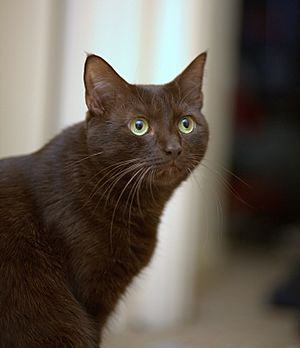Havana Brown facts for kids
Quick facts for kids Havana Brown |
|
|---|---|
 |
|
| Other names | Havana |
| Common nicknames | HB |
| Origin | England |
| Breed standards | |
| CFA | standard |
| TICA | standard |
| AACE | standard |
| ACFA/CAA | standard |
| CCA-AFC | standard |
| Notes | |
|
A phenotypically similar cat is recognized by the GCCF as the Suffolk Chocolate. The Suffolk is NOT the same as the Havana Brown. The standard for the breed is different and the cats used for outcross to develop the recently created breed is different than those found in the Havana Brown. The registers CFA, TICA, ACFA and LOOF all use the same breed standard for showing and breeding the Havana/Havana Brown Cat. The Suffolk Chocolate is not allowed in the breeding lines of the Havana Brown in any of these registers.
|
|
| Domestic cat (Felis catus) | |
The Havana Brown was the result of a planned breeding between Siamese and domestic black cats, by a group of cat fanciers in England, in the 1950s. Early breeders introduced a Siamese type Russian Blue into their breeding. However, using current genetic testing, it is believed that almost none remain in the gene pool.
It has been documented that self-brown cats were shown in Europe in the 1890s, one name given to these was the Swiss Mountain Cat. These disappeared until post-World War II, with the most likely explanation that the Siamese Cat Club of Britain discouraged their breeding. The Swiss Mountain Cat was never used in the breeding programs of the modern Havana Brown. However, they likely share genetics inherited from the Siamese.
Features and behavior
The Havana Brown is a well balanced, moderately sized, muscular short-haired cat with a body of average length. Sterilized animals can tend to become larger and somewhat chubby. They are a moderately active breed, compared to other short-hair cat breeds. The coat color must be warm brown, typically reddish-brown, with no obvious tabby markings (note that kittens will always show markings but they resolve as the cat ages and dissolve completely by one year). Whiskers must also be brown and the eye color green. The head should be slightly longer than wide, but should never appear like a wedge. In profile, the nose/muzzle should have a distinct stop and change in direction at the eyes. Paw pads must be pink or rose colored but should never be black. Ears tend to be moderately large. A Havana Brown should have no extreme features; specimens should be attractive and moderate. Males tend to be larger than females and are average in weight compared with other breeds.
The Havana Brown is an intelligent cat that often uses its paws both to examine objects and to communicate with its owners. Curiosity brings them to the door as visitors arrive rather than preferring to be hidden as many cats will do. It is not unheard of for a Havana Brown to place paws on someone's thigh and offer a meow of introduction. It is playful and curious, but rarely destructive unless left without companionship. While many are 'lap cats', a few are more content just to sit quietly beside their human companions. On the other hand, many Havana Browns prefer to ride on the shoulders of their human and help with daily activities. They love to play in and groom hair - it happens so frequently that there are Havana Brown owners who don't even notice their cat doing it until it is pointed out by an observer. It is an odd trait that most Havana Browns share.
Havana Browns become very attached to their family and do not thrive when left alone for long periods. They are curious and interactive and need to be a part of daily activities. It is common for the Havana Brown to become best companions with the family dog. Many owners also find it surprising how easily they can travel with their Havana Brown without the cat's objection.
The most likely explanation of the breed's name - and the one most shared by Havana Brown devotees - is that its coat color is very similar to that of the Havana cigars, however, some have also argued that the breed's name is also derived from the Havana (rabbit) which also shares the color. This is likely more accurate based on the recorded history in England.
Very little grooming is required. A gentle brushing and wipe with a damp cloth once or twice a week, along with a good quality diet, will suffice for Havana Browns.
There are no known genetic diseases associated with this breed. They may have a slightly higher occurrence of gingivitis than other breeds, this being contributed to their Siamese ancestry.
Recognition
The breed has been recognized for competition in the US since the late 1950s. It has been considered an endangered breed, since the breeding pool is very small. In the late 1990s, there were only 12 Cat Fanciers' Association-registered Havana Brown catteries and under 130 unaltered cats. Since that time, the breed has grown at a healthy pace. In 2015 there are now twice the number of catteries and breeders located around the world, with the majority located in the US and Europe.
See also
 In Spanish: Habana brown para niños
In Spanish: Habana brown para niños


